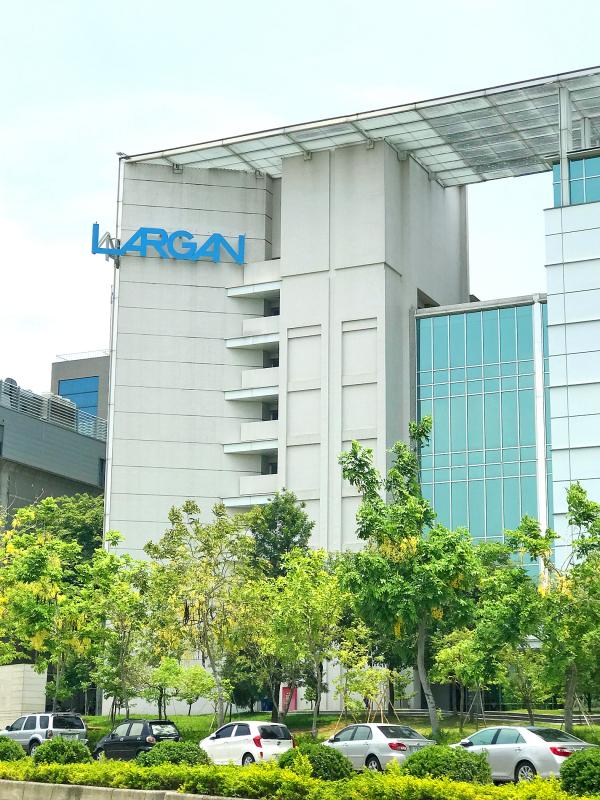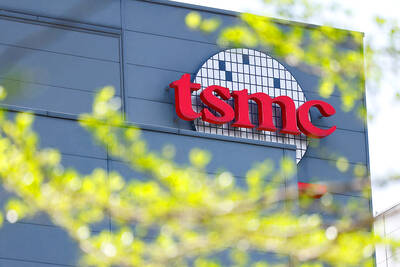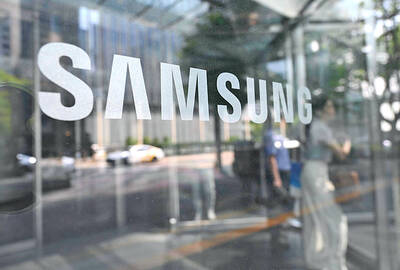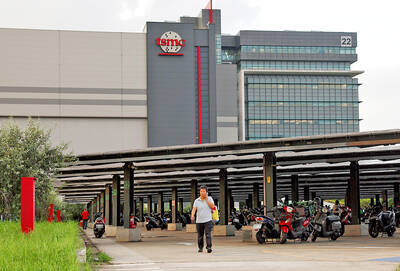Smartphone camera lens maker Largan Precision Co (大立光) yesterday posted a 0.63 percent month-on-month increase in revenue for last month, reversing a 16.73 percent monthly decrease in the previous month, but still declining 6.15 percent from a year earlier.
Consolidated revenue increased to NT$3.15 billion (US$107.2 million) last month from NT$3.13 billion in April, the company said in a statement, as major customers began to restock inventories ahead of new product launches in the third quarter.
The company reported revenue of NT$3.35 billion in May last year.

Photo: Chen Mei-ying, Taipei Times
High-margin lenses for cameras of 20 megapixels or more accounted for 10 to 20 percent of its shipments last month. Lenses for products of 10 megapixels or more comprised 50 to 60 percent of purchases, while lenses for 8-megapixel products made up 10 percent and lenses for products with lower resolutions contributed 30 to 40 percent, Largan data showed.
Cumulative revenue in the first five months of this year decreased 11.6 percent to NT$16.41 billion, from NT$18.56 billion a year earlier, the company said.
The global smartphone market has shown signs of weakness this year as lockdowns in cities in eastern China and supply chain bottlenecks continue to weigh on the industry, while a weak macro environment also placed a dent in consumer demand for consumer electronics such as handsets, industry watchers have said.
International Data Corp (IDC) last week forecast that global smartphone shipments would fall 3.5 percent annually to 1.31 billion units this year, a downward revision from its previous forecast of an annual 1.6 percent increase, while Yuanta Securities Investment Consulting Co (元大投顧) predicted global shipments would decline 2.3 percent to 1.295 billion units this year, from 1.326 billion units last year.
Largan chief executive officer Adam Lin (林恩平) on April 14 told investors that revenue for last month and April would be lower than March’s NT$3.76 billion due to seasonal factors and component shortages.
Order momentum is expected to come in stronger this month than last month as more Chinese cities ease their restrictive COVID-19 prevention measures and companies resume operations, Largan said.
Largan, whose customers include Apple Inc, Sony Corp, Samsung Electronics Inc and Huawei Technologies Co (華為), is scheduled to hold its annual general meeting on Wednesday, with shareholders expected to sign off on the company’s financial report for last year and re-elect board directors.
Lin is expected to shed light on the company’s outlook for the second half of the year after the meeting.
As a leading maker of optical lens modules, Largan also produces voice coil motors, contact lenses and sleep monitoring systems.

TECH TITAN: Pandemic-era demand for semiconductors turbocharged the nation’s GDP per capita to surpass South Korea’s, but it still remains half that of Singapore Taiwan is set to surpass South Korea this year in terms of wealth for the first time in more than two decades, marking a shift in Asia’s economic ranks made possible by the ascent of Taiwan Semiconductor Manufacturing Co (TSMC, 台積電). According to the latest forecasts released on Thursday by the central bank, Taiwan’s GDP is expected to expand 4.55 percent this year, a further upward revision from the 4.45 percent estimate made by the statistics bureau last month. The growth trajectory puts Taiwan on track to exceed South Korea’s GDP per capita — a key measure of living standards — a

Samsung Electronics Co shares jumped 4.47 percent yesterday after reports it has won approval from Nvidia Corp for the use of advanced high-bandwidth memory (HBM) chips, which marks a breakthrough for the South Korean technology leader. The stock closed at 83,500 won in Seoul, the highest since July 31 last year. Yesterday’s gain comes after local media, including the Korea Economic Daily, reported that Samsung’s 12-layer HBM3E product recently passed Nvidia’s qualification tests. That clears the components for use in the artificial intelligence (AI) accelerators essential to the training of AI models from ChatGPT to DeepSeek (深度求索), and finally allows Samsung

READY TO HELP: Should TSMC require assistance, the government would fully cooperate in helping to speed up the establishment of the Chiayi plant, an official said Taiwan Semiconductor Manufacturing Co (TSMC, 台積電) yesterday said its investment plans in Taiwan are “unchanged” amid speculation that the chipmaker might have suspended construction work on its second chip packaging plant in Chiayi County and plans to move equipment arranged for the plant to the US. The Chinese-language Economic Daily News reported earlier yesterday that TSMC had halted the construction of the chip packaging plant, which was scheduled to be completed next year and begin mass production in 2028. TSMC did not directly address whether construction of the plant had halted, but said its investment plans in Taiwan remain “unchanged.” The chipmaker started

MORTGAGE WORRIES: About 34% of respondents to a survey said they would approach multiple lenders to pay for a home, while 29.2% said they would ask family for help New housing projects in Taiwan’s six special municipalities, as well as Hsinchu city and county, are projected to total NT$710.65 billion (US$23.61 billion) in the upcoming fall sales season, a record 30 percent decrease from a year earlier, as tighter mortgage rules prompt developers to pull back, property listing platform 591.com (591新建案) said yesterday. The number of projects has also fallen to 312, a more than 20 percent decrease year-on-year, underscoring weakening sentiment and momentum amid lingering policy and financing headwinds. New Taipei City and Taoyuan bucked the downturn in project value, while Taipei, Hsinchu city and county, Taichung, Tainan and Kaohsiung